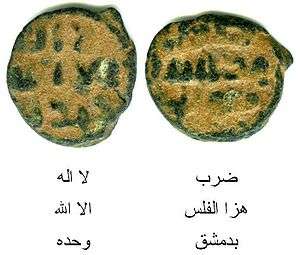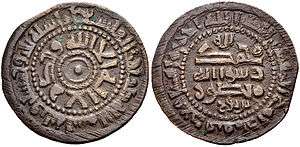Fals

A fals minted in Damascus between 696 and 750

Fals from the Samanid Empire minted in Bukhara, AH 353 (AD 964). Diameter 22 mm (0.87 in), weight 2.1 g (0.074 oz).
The fals (plural fulus) was a medieval copper coin first produced by the Umayyad caliphate (661–750) beginning in the late 7th century. The name is a corruption of follis, a Roman and later Byzantine copper coin. The fals usually featured ornate Arabic script on both sides. Various copper fals were produced until the 19th century. Their weight varied, from one gram to ten grams or more. The term is still used in modern spoken Arabic for money, but pronounced 'fils'.[1]
See also
Daughter currencies:
References
- ↑ Stephen Album, Checklist of Islamic Coins, Santa Rosa, CA, 2011, third edition, p. 7
This article is issued from
Wikipedia.
The text is licensed under Creative Commons - Attribution - Sharealike.
Additional terms may apply for the media files.